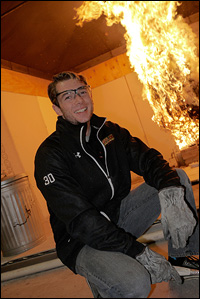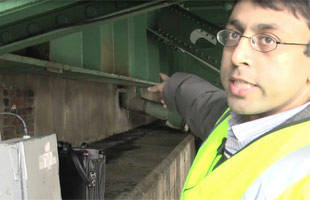News Story
Burning Christmas Trees…for Science!

Isaac Leventon, a doctoral candidate working with the Department of Fire Protection Engineering (FPE), studies upward flame spread with a focus on experimental measurement and computational modeling of the early stages of fire growth. He also teaches FPE's high school outreach program, An Introduction to Math and Physics through Fire Dynamics.
How long do you think it would take a five- to six-foot tall natural Christmas tree to go from a traditional holiday centerpiece to a ball of flame capable of destroying your home?
“Christmas tree fires don't happen that often, but when they do, they're three to four times as deadly as a typical house fire,” says Ph.D. candidate Isaac Leventon, a member of the Department of Fire Protection Engineering (FPE) at the University of Maryland’s A. James Clark School of Engineering.
That’s because in the time it took you to read this far, up to half of that tree will be on fire. It may go from ignition to completely engulfed in as little as 30 seconds.
Leventon recently demonstrated just how serious a Christmas tree fire is at an event held for students and visitors to FPE’s Fire Dynamics Laboratory, a facility designed to safely contain large burn experiments.
Here's what happened when we lit a Christmas tree that had been without water for 1 week. Don't try this at home! To watch what happens when a burning tree like this one activates a home sprinkler, see: ter.ps/treeburnsprk
“These fires grow fast and generate intense amounts of heat and smoke,” explains Leventon, who runs the department’s high school program, An Introduction to Math and Physics through Fire Dynamics. “That’s because natural trees are large, highly porous fuel sources that can easily draw in air as they burn. The air feeds the flames, and quickly makes things worse. As the fire continues to burn, it may ignite nearby objects like furniture and curtains.”
He set both natural and artificial Christmas trees ablaze to teach his students how to calculate burn behavior. This includes time to peak burning rate, burning duration, and maximum heat release rate–all things fire protection engineers take into consideration when designing buildings, testing product safety, or predicting the spread of a wildfire. Students compared their predictions to the actual behavior of each fire, and also learned that variables such as the tree’s size, moisture level, and what it’s made of must be taken into account.
“An artificial tree is not necessarily a fire-safe tree,” Leventon stresses. “Although fires involving natural trees outnumber artificial tree fires three to one, artificial trees are made from plastics which have complicated burning behaviors, like melting and dripping. Many artificial trees are manufactured with PVC, a material that produces hydrochloric acid when it burns.”
A healthy, well-watered natural tree presents less of a safety risk, he adds, but is also no guarantee of safety. Neither is a fire extinguisher.
“Fire extinguishers really just should not be used on Christmas trees,” he says. “They pose an inherent risk by forcing you to get very close to the fire. If that fire is small and well within the limits of the extinguisher, okay. If not, you’re fighting a lost cause, and at that point, the best thing you can do is to get out of the house.”
Leventon realizes that while he may sound devoid of Christmas cheer, he doesn’t think people should get rid of their trees–he has one himself. But he does think it’s important to know how quickly things can turn deadly. He recommends keeping natural Christmas trees well watered and clear of all potential fire hazards, and knowing when to let it go.
“Enjoy your tree,” he says. “But once it shows signs of drying out, like discolored or brittle needles that fall easily when shaken or touched, it's time to remove it and recycle it.”
Media Coverage:
PBS Newshour: “Christmas tree to blazing inferno in less than a minute.” (High-speed video clip, article)
PBS Newshour: "Sparking a love for science by studying how Christmas trees burn" (Video, transcript)
WJLA (ABC-7, Washington, D.C.): “Don’t let your Christmas Tree catch fire.”
(Video, article)
WJZ (CBS-13, Baltimore, Md.): “University Of Maryland Holds Holiday Fire Safety Demo.”
(Video, Article)
Photo Gallery: ter.ps/treeburnpics
Learn More:
According to the National Fire Protection Association (NFPA), U.S. fire departments respond to an annual average of 230 home structure fires that begin with Christmas trees. Each year, these fires cause, on average, six civilian deaths, 22 civilian injuries, and $18.3 million in direct property damages. Download a fact sheet (PDF) containing safety tips and more information about our experiments.
For More Information:
Visit the Department of Fire Protection Engineering’s web site
FPE’s high school outreach program
Isaac Leventon’s research
Published December 19, 2014











